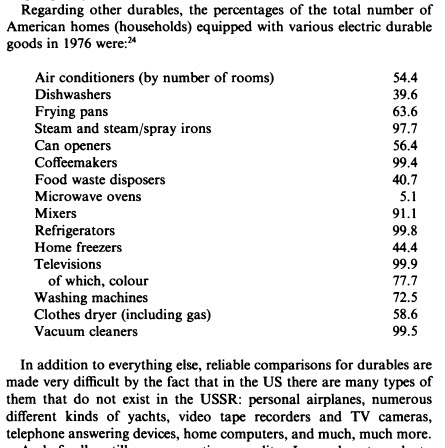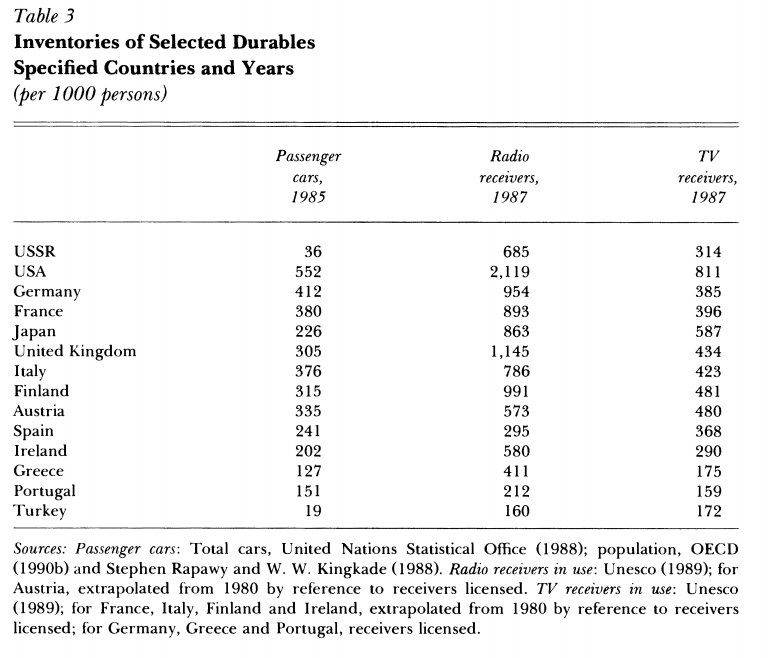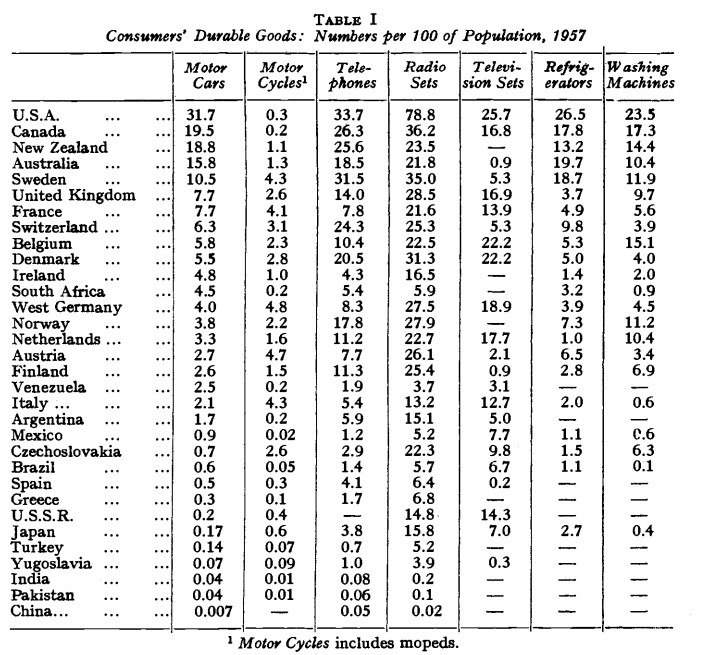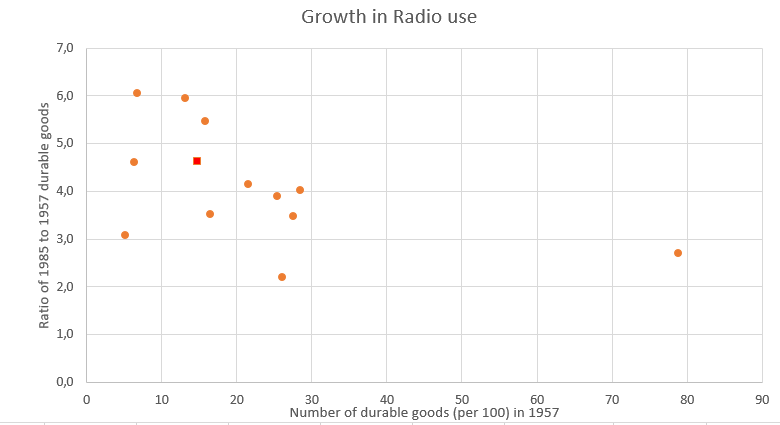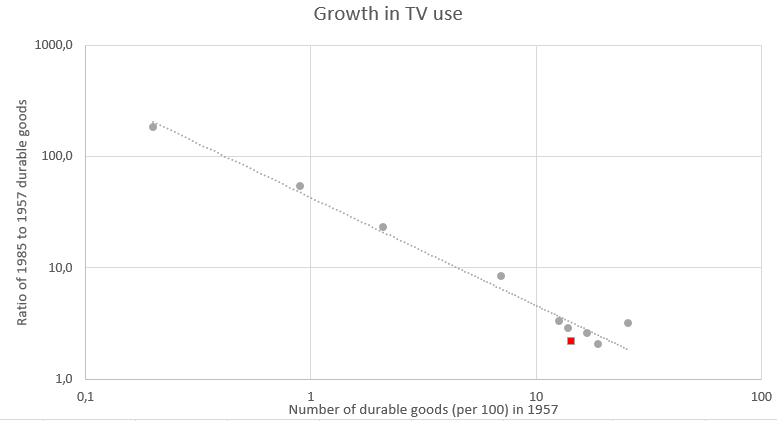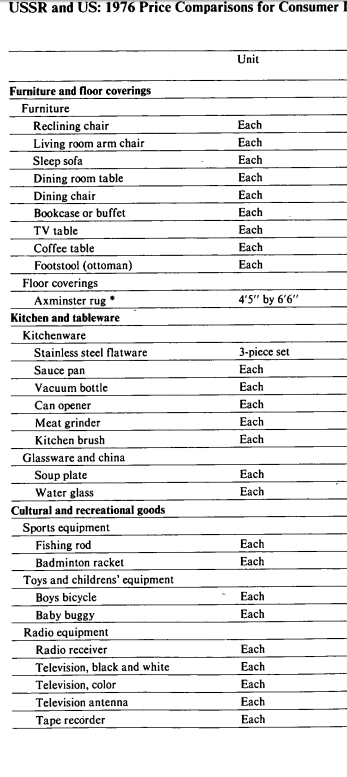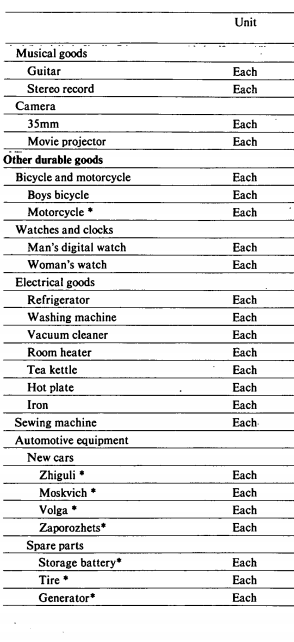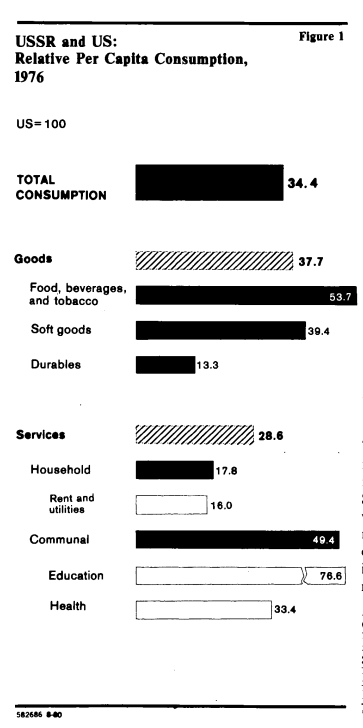The Soviet Union: Durable Goods
[Part of the Soviet Union series]
How many cars and refrigerators were there in the Soviet Union? Were they any good?
Durable goods refer to things like fridges, sewing machines, watches and automobiles.
For this chapter I draw again on Birman's Personal Consumption in the USSR and USA (1989, ch. 9).
The first thing Birman does is to warn the reader that comparisons are difficult given the qualitative difference between the products available in both countries,
Determining price ratios and parities for this group is hampered by the fact that many goods are not comparable, and very far from all exist in the USSR. In the opinion of experts[4], a typical contemporary Soviet sewing machine is similar to one used in the US 60 years ago. The standard Soviet one-door refrigerator is not produced in the US now. There are essentially no fully automatic washing machines, electric (or gas) clothes dryers, toasters, or air conditioners in the USSR(2).
(2) This was the opinion of American experts. In the words of lzvestiya, 3 April 1979, p.3, Soviet vacuum cleaners 'are 20 years behind modern standards'. Home air conditioners recently began to appear, but their quality is bad. The people have not been quick to buy them (Kommercheskiy vestnik, 1982, no. 6, p. 6), although there are no central systems in apartment buildings. Toasters have also begun to appear, but they are not selling well either.
[4] This refers to Consumption in the USSR: An international comparison (Schroeder, G.E. & Edwards, I. 1981) which draws from official Soviet data, Soviet and Western journals, and CIA estimates.
Total durable consumption in the USSR was one eight the level in the US. . Within both countries consumer's budgets, Soviets allocated more money to highly needed 'basic' goods while Americans could afford less essential equipment (recreational goods, sports equipment, cars...). Curiously, Soviets consumer a large amount of jewellery and watches, but Birman is not very convinced by this figure.
Consumption rates do not determine how many durable goods people are actually enjoying:
Americans already have a huge amount of durables and buy new items primarily to replace what has worn out or one out of style. The Soviet people are at a significantly lower absolute level of consumption of durables and the rate (not absolute amount!) of their purchases is higher. Therefore, judging volume of consumption of durables on the basis of the amount of purchases during the year substantially distorts the results of the comparison in favour of the USSR.
Regarding household appliances, in 1976, only two thirds of Soviet families had refrigerators, and sewing and washing machines. Only one fifth had vacuum cleaners. The number of coffee grinders and pressure cookers was also low. In contrast, most families in the US enjoy these appliances. And as mentioned before, there were differences in quality,
The difference in the quality of equipment is colossaI. The freezing compartment of Soviet refrigerators is small and there are no automatic ice-cube makers. American washing machines operate automatically and on different cycles, while Soviet machines merely spin the clothes - the difference is like that between silent movies in the 1920s and modern cinema.
There were 223 TV sets per thousand residents in the USSR (vs 571 in the US) in 1976. People in Moscow had three channels they could watch and people in Washington had seven. Only 10% of Soviet televisions were in colour, and 1/5 of the territory could not receive colour broadcasts. 31% of Soviets could only watch one channel.
Soviets were still producing tube based radio receivers (those were not in production in the US anymore) and total production was less than in the US, 8.5 million vs 44.1 million.
For a similar population, the US had 98 million passenger cars vs just 5 million in the USSR. This is not because of a difference in preferences. According to Birman, Soviet citizens dreamed with owning their own personal automobile.
Another thing that must be mentioned is the differences in ownership of durable goods between cities and the rural areas. The relevant numbers here are the per family numbers. Rural areas, as one might expect, lagged behind cities in ownership of various goods.
The summary table in the books shows the above mentioned figure of one ninth
We can also examine how the situation was in 1985-7, a few years later. From Bergson (1991)
We also have data for 1957, from Knox (1959). This paper is older, and so its quality is not as good
It would be interesting if someone tabulated the relevant data to make some nice charts to see how each category changed in each country.
Fortunately, I'm that someone:
For cars we can say that growth was obviously low (I excluded both the Soviet Union and Turkey as outliers to get the fit). For TV, it was as slightly below what one would have expected given the starting point.
We come to that moment in my post where you find extensive copy-pasting from other sources. In this case, from Chernyshova(2011) . She discusses quality of goods, and the process of buying them, plus the perceived higher quality of Western goods by Soviet consumers, which matches what Birman and the CIA reported.
The dependency of consumers on the performance of state industry as the sole producer of household electrical goods and on state policies meant that consumer agency had its limits. Insufficient output and frustrations of the retail network meant that shopping for desired gadgets, whether a washing machine, a mixer, or a television set, never really became as simple or straightforward in the USSR as it was in the West. Unlike Western market economies, in the Soviet Union finances were not the main obstacle to acquisition.70 While goods varied in availability, the majority of purchases involved queuing, which ranged in length from several hours to several years; often they required physical endurance and just sheer luck. The case of refrigerators is particularly telling: they were sold through the system of waiting lists and postal notifications, which had been designed to make trade in high-demand goods more efficient, but, coupled with the absurdities of Soviet retail practices, turned out to be downright Kafkaesque. One shop in L’viv gave customers only a one-hour slot between 5 p.m. and 6 p.m., during which they could sign up to buy a refrigerator, despite the fact that the store was virtually empty for the rest of the day. During that special hour, one assistant had the task of taking down names of about a hundred clients, which resulted in mayhem.71 The narrowly designated time slot was likely a method of restricting the number of people signing up for a refrigerator; the demand exceeded supply, despite the waiting time of one year. But lapses in organization, which accompanied the process, were unlikely to have been intentional. The L’vov shop failed to inform its patrons that in order to sign up they had to bring along a blank postcard to be used to notify them when their refrigerator arrived in the shop. Having reached the counter, customers had to drop their place in the queue and rush about the neighboring streets in search of a place to buy a postcard, making the entire endeavor even more stressful.
Successful registration got one only halfway to the desired refrigerator. After months and even years of waiting, when the long-awaited postcard arrived, the lucky buyer had to rush to the store to pick up the item in person. The rules concerning collection were rigid. Trud reported the case of an old man from the town of Ivanovsk, who had been waiting for his refrigerator for two years but had the misfortune to fall ill when the notification arrived. This was a mistake. When his children took his postcard to the shop to collect the refrigerator in his stead, the shop refused to deal with anyone but the person who had filled out the postcard two years ago. Insensitive to the pleas of the relatives, the shop personnel kept demanding that the old man show up “dead or alive” or they would sell his refrigerator to the next in line. It took the interference of no less powerful a figure than the head of the Ivanovsk Municipal Department of Trade to allow collection by the relatives.73 This incident is a useful reminder of serious limitations on Soviet consumers’ agency and autonomy. The intervention of a high-ranking official required for the purchase to take place highlights consumers’ dependence on the state not only as the sole producer and distributor of goods but also as the ultimate arbiter in overcoming the red tape and inefficiency of its own retail system. [...]
It was no accident that Soviet consumers came to insist on specific brands: quality of technology, although improved, could vary widely, and on the whole electric items tended to be faulty more often than other types of consumer goods, while repair services were notoriously poor and overworked. Pensioner K. Mukhina from Kostroma told the editors of the newspaper Sovetskaia torgovlia (Soviet Trade) that problems with her newly acquired Biryusa-2 refrigerator, which had quickly broken down, turned her into “such a nervous wreck that eventually I will either chop up this fridge with an axe or hang myself on its handle.”78 It turned out that fixing a refrigerator was no easier than obtaining it: Mukhina had been told her device would be repaired within one year. When she explained in her letter why this seemed like a “woe” (gore), she emphasized her consumer rights and a sense of entitlement to honest treatment, which she explicitly linked to the Soviet regime: “I had been saving money for five years, waited in the queue for a year, and what now? I am looking at this refrigerator with horror. I spent so much money on it (yes, for me it is a lot of money, because my pension is only 49 rubles). Never did I think that in our Soviet Union it is possible to get swindled like that.” [...]
The Soviet Union did not have a market economy, of course, but it, too, had to compete as a producer of electrical goods. Its arch-competitor was the West, a fact that the American Exhibition in Moscow served to highlight as early as 1959. The competition had ideological purposes, but it also had a tangible economic dimension. **Western goods were highly prized in the Soviet Union, because imports were limited and because their quality was likely to be superior. As the isolation of the USSR diminished, this superiority gradually became an open secret.**82 This did not mean that some Soviet brands did not enjoy a reputation for being reliable, as we have seen earlier, but losing consumers’ faith could be more than embarrassing: it cost both money and ideological face. The deputy minister for education Liubov’ Baliasnaia aptly summarized the problem at a public roundtable on youth problems in 1973, when she explained young people’s infatuation with all things Western: “We produce sputniks but we don’t have pretty underwear for women.
82 A 1986 collection of articles on “rational consumption,” for instance, stated bluntly that “many [Soviet-made] products are inferior to the best of their foreign counterparts in terms of key technical and consumer characteristics.”
One could assume that at least with electrical appliances the situation might be better, and arguably it was. After all, as mentioned above, the same enterprises involved with production of space and defense technologies were charged with making washing machines and refrigerators. But this approach did not always yield the desired results. These enterprises were reluctant to digress from working on their prime specialties in order to engage in consumer goods production and haggled with state planners in attempts to lower their targets.84 For them, the production of domestic appliances had secondary priority, so even here it did not receive sufficient resources and technological attention. Consequently, the quality of these “stepchildren” of heavy industry suffered. Electrical durables were among the goods that caused the most trouble to their owners and most often broke down. 85 **The implementation of innovation was often slow due to the cumbersome planning system, which became particularly noticeable as consumer demand and standards rose, prompting the newspaper Moskovskaia pravda to complain in 1975 that by the time a new device entered the market it was already thoroughly outdated and “failed to satisfy the contemporary requirements of technical aesthetics.”**86 This did not bode well for the competition with the West in providing modern home technology
85 Obzory pisem radioslushatelei, 1971 // GARF. Fond 6903. Opis’ 42. Delo 2. The analysis of letters from radio listeners conducted by the USSR State Committee for Radio and Television in 1971 showed that most of the (numerous) letters complaining about the poor quality of consumer goods referred to refrigerators, vacuum cleaners, transistor radios, TV sets, and record players. That this had been a problem for many years is also stated in the 1985 VNIIKS report.
More than two decades since the ushering in of the Soviet technological revolution, the situation with housework had hardly changed. It had been anticipated that various devices would help free up approximately 1,000 hours per year per family; instead, the time spent on domestic chores remained the same in 1980. Literaturnaia gazeta saw Soviet underachievement in the transition to comprehensively mechanized housework as a cause for embarrassment, stating it was “paradoxical … [that] today, in the age of the atom, computers, and universal electrification, our domestic life is extremely conservative.”109 Statistics-favored goods such as TV sets, refrigerators, and washing machines aside, the presence of other kinds of domestic gadgets in the home was obstructed by a host of difficulties, and it was not just about shortages. Food processors or microwave ovens were costly and often bulky. Even smaller appliances such as juicers occupied too much space in tiny Soviet kitchens and could not be left standing permanently on a kitchen table, but had to be completely disassembled and put away after every use. There were other inconveniences, according to the press. Even in large kitchens, several appliances could not be used simultaneously because there were only one or two outlets in the kitchen, and the voltage in the electrical circuit was too low to sustain all of the machines working together
From this paper, we can also try to study how durable were Soviet durable goods. According to Chernyshova(2011), ZIL refrigerators around 1976 lasted for 18 years or more. But the more popular ones were the 'Biryusa' (Mentioned before). How does this compare with Western goods? We'll come back to that in a second.
For cars, I haven't been able to find sources in journals, but here someone reviews the Fiat 124 vs the Lada 1200 (VAZ-2101), which is a copy of the former car. The author of the review doesn't think the Lada was a superior car. The Fiat, however, was produced until 1974, while Ladas were still being made until 1988, so this comparison is tilted in favour of the Lada.
Buying cars was even more difficult than for less expensive goods,
**Waits were legendarily long, sometimes ten years, but usually in the range of four to six.**44 Problems of determining which organization’s or institution’s queues had priority, the maintenance of individual's’ place in the queue, and illegal (bribe-induced) queue jumping were endemic, especially as it was well known that “members of ‘elite’ groups . . . receive special consideration in the allocation of cars.” Aside from high-ranking party officials, this would have included members of prestigious organizations such as the Academy of Sciences and the Writers’ Union; industrial executives; outstanding artists, actors, professional athletes, and other recipients of honors and medals; and disabled veterans of World War II. [...]
“In Russia,” wrote the authors of a book on “automania,” “they say that owning a car brings joy twice in an owner’s life—when it is bought and when it is sold. In between there is only torture.” Siegelbaum (2006))
To compare the quality of Soviet and Western goods, we draw from Malcolm & McKay (1988)
Automobiles
Various soviet and Western cars were tested, and
Hence an overall assessment of the car [Moskvish 412] from Motor's road test points towards a 1.5 litre car capable of adequate performance, with large passenger space, well equipped for driver maintenance, but lacking in good finish. These characteristics would point well towards Soviet requirements for a car intended for public transport and some private use by drivers trained in car maintenance, although poor ventilation and bodywork finish may lead to shortcomings in use in the Russian climate.
Furthermore, because of the large Soviet demand for passenger cars, it would have been natural for Soviet policy to concentrate on the immediate expansion of production of an adequate model for Soviet conditions, particularly in terms of ruggedness, rather than delay production to remove design imperfections viewed from the Western marketing standpoint, especially as its low selling price in the West would compensate for many of these. The ruggedness of the Moskvich 412 was also demonstrated by its successes in two rallies, namely the London-Sydney rally in 1968, run over a distance of some 16 000 kilometres in difficult terrain, and the London-Mexico rally in 1970, run over a distance of some 26 000 kilometres through 25 countries of Europe, South America and Central America. All four of the Moskvich cars completed the London-Sydney course, and the Soviet team was one of four to complete the course, from twelve contestants.
Hence, although one Soviet source considered the Moskvich 412 to be equivalent to the Vauxhall Victor 1600 in terms of several technical characteristics (see Table 5.2 above), CA tests suggested that it was far below this 1962 British-designed model in terms of general safety.
Of the Lada or Zhiguli, he says:
The road test reported in the Autocar magazine compared the performance of the Lada, in terms of top speed, acceleration and fuel consumption, with four then contemporary UK manufactured cars of 1300 cc engine capacity (Ford Escort 1300 XL, Hillman Avenger 1300 GL, Morris Marina 1.3 and Vauxhall Viva DL). It was found to have the highest top speed of the four models tested, and was ranked in third place for economy of fuel consumption. Its rate of acceleration was found to be lower than the majority of the models tested, but not substantially lower to prevent Autocar from rating the Lada's performance as 'perfectly satisfactory'.
The handling of the car was described as 'traditional' in view of the modified ('beefed up') suspension system used on this car compared with that used on the Fiat prototype model. This modification was, no doubt, carried out to adapt the car for use in Soviet road conditions, since Autocar noted that 'on ordinary smooth roads the ride is good and well damped, but we found that the Lada really came into its own on rough unmade roads where it could cope with almost anything. There was little pitch or roll, and the Lada felt extraordinarily stable.' This good performance under rugged conditions, however, was obtained at the expense of lightness of handling under normal road conditions. The performance of the brakes was also found to be satisfactory, although their lack of sensitivity to feel **('totally dead feel') was considered to be a disadvantageous characteristic which could have been corrected by the fitting of a vacuum servo.**
This model was also praised for the manner in which the engine was laid out under the bonnet. This layout, combined with the toolkit and maintenance manual supplied with the car ensured that the owner should be capable of servicing the car in a professional manner, this feature reflecting the higher degree of owner maintenance likely to be practised in the Soviet Union. The main criticism of the car, in addition to those of heavy steering and insensitive braking referred to above, were aimed at the lack of driver support provided by the front seats, and the poor performance of the light bulbs provided with the car. It was also noted that although the car performed admirably under rugged conditions, inadequate protection of the handbrake central lever caused the rear brakes of the test car to be locked on when travelling over rough roads.
The magazine concluded its road test with the comment that**'we must congratulate the Russians on catching up so quickly (albeit with Italian advice and assistance) with the rest of the world's motor industry. The Lada 1200 is a thoroughly sound car, let down perhaps by sticking steering and dead brakes. But these are matters which can be rectified with a minimum of cost.'** Similar reports were also received for the 1300 and 1600 models produced subsequently. Since this range accounted for almost 50 per cent of total annual Soviet passenger car output by 1975 24it can be concluded that the Soviet passenger car industry, although not in the vanguard of passenger car design technology, has become capable of producing a large production of its total output to design requirements demanded by the international market for average priced saloon cars of 1.2-1.5 litres engine capacity. This model has subsequently been modified externally and internally, with a broader range of options introduced. This has enabled the car to remain competitive within the price range in which it is located.
Hence, Soviet cars can be judged fairly good, but not on the technological vanguard. They did begin from a lower technological level, but they also got assistance from Fiat, so judging whether they 'should' be at the technological vanguard is difficult.
Refrigerators
Now, refrigerators,
By early 1978, 77 per cent of Soviet families were in possession of a refrigerator, which subsequently increased to 90 per cent by 1984. In spite of this impressive growth in output, however, there is evidence to suggest that Soviet consumer requirements were not fully satisfied, as a result of a shift in demand to larger capacity refrigerators which occurred in the mid-1970s. It was estimated at one stage that between 60 per cent and 70 per cent of overall demand (measured by orders placed) was for refrigerators with storage capacities of 200 litres and above, whilst only 23.7 per cent of the industry's production capacity had been allocated for this purpose.
The situation in large Soviet towns and cities was such that over half the demand for large capacity refrigerators was not being satisfied; and in rural and outlying districts there were reports which indicated that nearly 80 per cent of the demand was not being met, in spite of a large number of product models being manufactured.
[...]
The drawbacks and shortcomings of the Soviet refrigerator industry have not been confined just to matters of demand and supply imbalance. According to accounts of poor design and inferior performance of refrigerators which appear regularly in the Soviet technical and national press, the post-inspection rejection of refrigerators is still a commonplace occurrence.
[...]
From a comparative assessment, it appears that theSoviet refrigerators selected for comparison were apparently similar in specification, and quality to analogous Western products (see Tables 6.1 to 6.4). In addition, there are also many similarities for the general technical conditions for both sets of refrigerators, showing that during test and inspection procedures, similar technical demands are placed on both Soviet and Western designers and manufacturers of domestic refrigerators. (see Table 6.5).
There are certain factors present, however, which may have given rise to a high quality level for the 'Biryusa' refrigerator, compared with the broad range of appliances produced in the USSR. In the first place, the Soviet appliance chosen for comparison is an export model.
The manufacturer of 'Biryusa' refrigerators in Krasnoyarsk also appears to use the best and most up-to-date techniques in production and quality control of the industry concerned; possibly because the factory is responsible to an industrial ministry in the defence sector. 19 The acknowledged privileged position of the defence industries, with regard to resource allocation invariably means that the attainment of high standards of production is a less difficult task than for enterprises making similar products in the civilian sector.
Before closing this chapter, a few more comments will be made about 'Biryusa' refrigerators, particularly those models which are on sale in Britain under the trade name of 'Snowcap'. At a retail distributor, located near to the authors' university, both Soviet and Western models of refrigerator were displayed side-by-side, and a practical method of comparison was possible.
After a brief examination it became apparent that the Soviet models were lacking in some finer points of cabinet design (paint finish quality, and tolerances for fitting doors and other fixtures). The higher priced Western models also included a greater number of shelf positions, as well as catering for a wider variety of drinks, dairy products and perishable foodstuffs. An assistant of the distributor in question assured one of the present authors that despite these shortcomings, 'Snowcap' refrigerators still presented a sturdy and reliable unit within the lower price range of the market and, collectively, these characteristics were proving a very effective selling point. On the question of their reputation within the retail market, discussions with a multiple retailer in the Midlands area revealed that for over eleven years 'Snowcap' refrigerators had maintained a reputable market position and created an atmosphere conducive to good customer relations.
The book concludes:
The research described in this book was initially commenced as a consequence of the various published Western perceptions that Soviet product quality was generally lower than that encountered in the West (see Chapter 1), although much of the evidence advanced for such perceptions was itself largely based on secondary information in published reports rather than primary data on product specification and performance. The causes of these perceived views of the 'quality gap' existing between Soviet and Western products has been ascribed to a number of factors operating in the Soviet economy such as the strong seller's market created by tight central planning, skill shortages, and management styles caused by the output-related incentive scheme originally introduced for rapid economic growth in the 1930s.
Although Soviet products were considered to be adequate in terms of mechanical construction and praiseworthy in terms of robustness, there was also a general view that these were achieved at the expense of lightness in construction. Furthermore, although the simplicity of the product's design led to ease in service and maintainability, there were frequent criticisms that the lack of sophistication in design led to inconvenient operation. This was particularly the case for those product groups where the increased application of electronic components to provide faster setting and more accurate control has become generally accepted by Western manufacturers. Criticisms were sometimes made about the product's reliability, although this could be balanced by ease of service; and also about the general out-of-date design of many products. **In summary, most of the Western assessors viewed Soviet consumer products as mechanically adequate, simple in construction and to service, and robust; but heavy, sometimes unreliable and inconvenient to use, lacking contemporary control devices, and generally dated and unsophisticated in design and appearance. At the prices for which these products were sold on Western markets, however, the balance of their advantages and disadvantages led to the conclusion that they were usually value for ****money.**
As a final point, when considering the appropriateness of Soviet products for Western markets, it is apparent that these products appear to meet a particular niche in the market where low price, simplicity, serviceability, and robustness are valued more highly than sophistication, lightness and elegance. In other words, the overall balance of quality characteristics are adequate for products at the mature stage of the product life cycle, where a combination of certain minimum technical standards combined with a highly competitive price are probably more important than advanced technological sophistication.
Conclusion
In some household appliances (refrigerators, TVs, radios), the Soviet Union managed to provide its population with an amount that increased as one would expect from comparisons with other countries. Automobile ownership was really low, and this is not explained by a lack of demand, but of supply. Overall consumption of durable goods is estimated by Igor Birman and the CIA in one ninth of US levels.
For other goods, like juicers, microwaves, sewing machines, washing machines, or vacuum cleaners, ownership levels were lower (apparently refrigerators, TVs and radios were given priority to make statistics look nice).
In general, quality levels seem to range from almost on par with Western standards (for automobiles) to slightly behind (refrigerators) to far behind (vacuum cleaners).
All in all, the consumer experience (for durable goods) of the Western consumer was better than its Soviet counterpart. First, one had to go through long waiting lists or queues, up to years in the case of cars. Then visit the shop at a specified time to actually receive the good in question. Once bought, the quality varied as I've mentioned, but usability and aesthetics in general seem to be below Western standards. Regarding durability, it's an open question whether Soviet durable goods lasted longer than Western's. We would have to compare, say, refrigerators back then in both regions. Some of the sources mentioned above cast some doubt regarding the popular idea of the superior reliability of Soviet durable goods. This, however, might be grounded in an easier serviceability compared to Western appliances. So Soviet goods perhaps didn't last longer than Western by default, but their life could be extended over prolonged periods by successive repairs, something that given the long waiting lists involved, was preferable to buying a new one. Different customers will have different preferences regarding repairing vs acquiring a new model, but the latter option was difficult for Soviet consumers.
References
Bergson, A. (1991). The USSR before the fall: How poor and why. The Journal of Economic Perspectives, 5(4), 29-44.
Birman, I. (1989). Personal Consumption in the USSR and the USA. Springer.
Chernyshova, N. (2011). Consuming Technology in a Closed Society: Household Appliances in Soviet Urban Homes of the Brezhnev Era. Ab Imperio,2011(2), 188-220.
Hill, M. R., & McKay, R. (1988). Soviet product quality. Macmillan.
Knox, F. (1959). Some international comparisons of consumers’ durable goods . Bulletin of the Oxford University Institute of Economics & Statistics, 21(1), 31-38.
Schroeder, G., & Edwards, I. (1981). Consumption in the USSR: an international comparison. Joint Economic Committee, US Government Printing Office, Washington, DC.
Siegelbaum, L. H. (2006). Cars, cars, and more cars: the Faustian bargain of the Brezhnev era. In Borders of Socialism (pp. 83-103). Palgrave Macmillan US.
Appendix
You might be wondering what goods were taken into account to arrive at the one ninth figure. From what I've said here, it seems like Soviet ownership of a few goods was not that low. Here I give you the full list of items that the CIA considered as durable goods to get the one ninth figure. As you'll see, it covers far, far more than what I've discussed here. The calculations themselves are not straightforward, and they involve prices (from actual shops in Minsk, Moscow and Murmansk), exchange ratios between dollars and rubles, household surveys, consideration of state subsidies, and quality differences.
Comments from WordPress
- The Soviet Union series | Nintil 2016-06-06T21:46:41Z
[…] The Soviet Union: Durable Goods […]
akarlin 2016-06-06T23:33:09Z
Almost all of this rings true.
Curiously, Soviets consumer a large amount of jewellery and watches, but Birman is not very convinced by this figure.
Except perhaps this. I suspect this actually was the case, since people generally had a lot of savings (due to the waiting lines for other types of consumer goods) and translating them into jewels and watches (and chandeliers).
Incidentally, the quality of Soviet watches was very high, to the extent that some brands remain sought after collectors' items to this day.
Artir 2016-06-07T22:32:32Z
I copypaste from Birman's:
A figure that stands out is the twice as large share of consumption of watches and jewellery in the USSR. In 1976 the average Soviet spent R7.61 on jewellery and R3.7 on watches.3 Certainly,jewellery is used by the rich of America no less than in the USSR: it is much easier to buy, gold and jewellery are comparably much cheaper, and in the USSR not everyone would wear them in public. A more careful look reveals that there are no prices for jewellery in the study, and nothing is said about how they were weighted. I mentioned the poor representativeness of the selection of watches in Chapter 3. On the other hand, gold jewellery is becoming more and more popular in the USSR.4 In general, I have no grounds to agree with or reject the result on this subgroup.
It would fit with your point. This paragraph is the only time I've come across watches and jewels in the USSR so far.
Citation
In academic work, please cite this essay as:
Ricón, José Luis, “The Soviet Union: Durable Goods”, Nintil (2016-06-06), available at https://nintil.com/the-soviet-union-durable-goods/.


